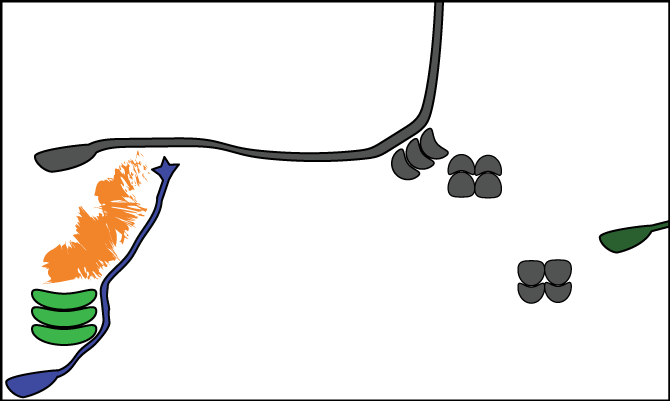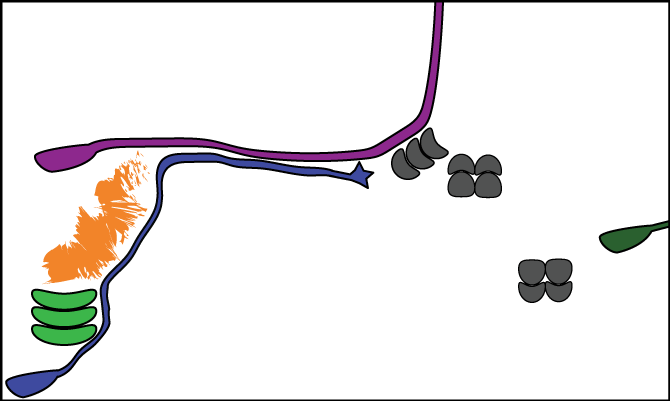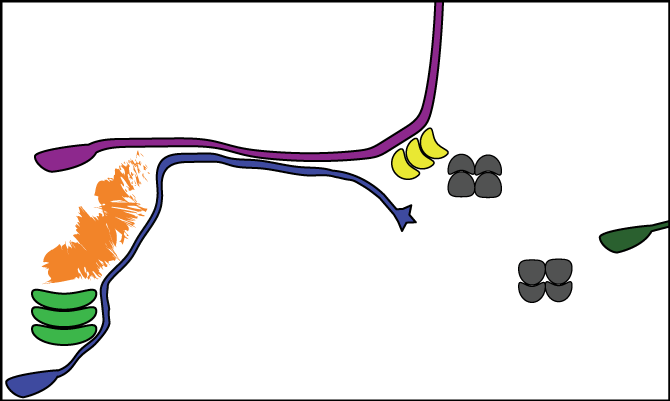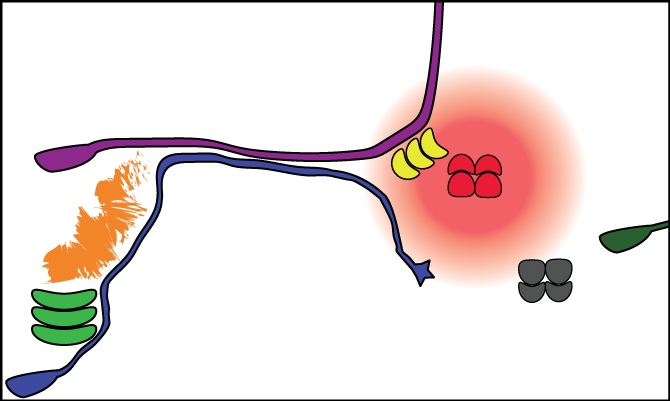Answer
There are four main classes of axon guidance molecules: molecules can act by contact or at a distance, and they can be attractive or repulsive.
In all cases, they modify the balance between growth and collapse at the tip of the axon, the "growth cone", resulting in the axon moving towards or away from the source of the signal.
The Axon Guidance Problem

The image above shows a recently-born neuron (dark blue, bottom left). The purpose of the neuron is to connect its inputs (not shown) to an output neuron (dark green, center right). In order to do so, it must extend a long, thin cellular process, known as an axon, across an expanse of space that is about 20 times its size in order to make a physical connection with the output neuron, also known as a chemical synapse.
In some cases, this distance can be even longer: the neurons that control your toes extend their axons almost a meter, even though their cell bodies are only about 25 microns across. For comparison, this is like connecting two apples on the opposite ends of Manhattan with a catheter. Without using Google Maps!
In order to understand how this process works, we first need to understand how an axon grows at all. Then, we'll talk about how signalling molecules can modify the growth process, allowing the axon to sprout out of one neuron, make a variety of twists and turns, and then finally attach to its target.
Growth Cones
The key structure for axon guidance is the axonal growth cone, a complex, dynamic structure that somewhat resembles The Blob (pictured below, click for video).
Growth cones arise at the leading edge of the axon. Rather than having a relatively stable skeleton made out of microtubules, as the rest of the axon and the cell as a whole do, the growth cone has an actin skeleton, which, like Lewis Carrol's Red Queen or the Pink Panther's column, is caught in a tug-of-war between two opposite processes. As the skeleton grows at one end, it simultaneously is broken down at the other, so its length does not change.
Its length doesn't change, that is, if the two processes occur at the same speed. If one occurs faster than the other, the growth of the skeleton becomes less like the myth of Sisyphus and more like the story of the frog in the well: two hops forward, one hop back.
Axon guidance occurs when outside factors influence this growth process, causing it to increase in speed or decrease in speed. In particular, the growth cone has, at its tip, a number of "fingers" that stretch out. Fingers that encounter factors that increase growth will get longer, while those that encounter factors that decrease growth will get shorter or even collapse.
Eventually, the slower process that builds up the solid, microtubule skeleton will catch up to this portion of the growth cone, solidifying it in the shape induced by the incoming signals. The fingers have continued past this point, now encountering new signals, which will shape the next stretch of the axon, and so on and on.
In motion, the process can be quite mesmerizing: fingers stretch and collapse, spreading out and around and over each other as their growth processes speed up and slow down. The static result is a precisely-shaped axon. Check out the videos below to see the process in action!
Click for videos of growth cones in action!
Types of guidance cues
External signals played an important role in determining the course of the axon in the above model.
Let's follow the neuron from the example at the beginning of the post as it encounters all of these signalling mechanisms.

First, it encounters the three pickle-shaped and pickle colored cells in the bottom-right corner.
The growth cone makes physical contact with these cells, and the proteins in the cells' membranes have the opportunity to interact.
In this case, these proteins encourage the growth cone to grow more rapidly, causing it to stay close by and increase in size.
This mode of axon guidance is called "contact-mediated attraction". It comes in three flavors, depending on the substrate. Classically, contact-mediated attraction occurs with a lamina, or tightly-bound collection of cells.

It can also occur when the neuron encounters the extra-cellular matrix, a dense network of elastic proteins, primarily collagen (pictured in orange).

One of the most prominent cases of contact-mediated attraction for axon guidance is fasciculation, or the formation of a fascia, or bundle. In this case, an axon encounters another axon and "hitches a ride", following the so-called pioneer axon (purple). Because axons often travel in bundles (known to anatomists as nerves), fasciculation is a very common component of axon guidance.
Fun fact: the Latin word fascia is the root for our English word fascism, thanks to Il Duce Mussolini's fascination (fascination having no etymological relation) with Roman authority and symbolism, in particular the fasces, or bundle of sticks, which represented the superior strength of the Roman state as a corporate entity compared to its constituent components, i.e. the individual Romans.

Contact does not always lead to attraction. Above, our intrepid growth cone has encountered some cells (yellow) expressing repulsive factors, causing it to grow in the opposite direction. This form of guidance is known as contact-mediated repulsion.

Not all axon guidance is mediated by direct contact. Above, the neuron has encountered some cells (red) that secrete a repulsive factor that diffuses out into the extracellular fluid, producing a gradient of that factor (also red).
This factor can activate receptors on the surface of the cell, modifying the internal actin dynamics and resulting in the axon either travelling towards the source of the signal or away from it. In the case above, the axon grew away from the source. In this case, the mode of axon guidance is known as "chemo-repulsion".
In the image below, the axon encounters an attractive signal (light blue), and so grows toward the source. This mode of axon guidance is known as "chemo-attraction".

The result of the combination of all of these local signals is that the neuron has produced an axon with a striking global property: it travels on the scale of about half a millimeter to make a synapse with a specific target neuron.
Coda
Note that the pioneer neuron (purple) travels along a different path than our neuron, even though it is exposed to many of the same signals.
This is a critical feature of axon guidance: the same signal can have opposite effects, depending on what proteins are expressed in the growth cone of that neuron at that time.
If you're interested in how neurons decide which proteins to express, check out the post on the factors that turn neural precursors into neurons. If you're interested in how cells decide to become neurons in the first place, check out the post on morphogenesis and the spinal cord.
 )
)